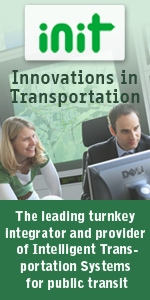

| In This Issue |
| » BREAKING NEWS |
| » NEWS HEADLINES |
| » SAFETY AND SECURITY |
| » COMMENTARY |
| » PEOPLE ON THE MOVE |

The 14 help wanted ads in this week's classifieds offer such jobs as a transit agency general manager and an executive director in academia!
| SAFETY AND SECURITY |
King County Metro Transit Sounds a ‘Wake-Up Call’
BY MICHAEL LEMESHKO, Supervisor, Transit Safety, King County Metro Transit, Seattle, WA
Walking down the street in Washington State may seem like an innocuous activity, but each year hundreds of pedestrians are seriously hurt or killed in accidents. Both in urban hubs such as Seattle and Bellevue and in the suburbs and rural areas, pedestrians and motor vehicles come into too-close contact each day.
This year, King County Metro Transit is embarking on a safety awareness campaign targeted at reducing pedestrian accidents in and around transit hubs.
According to the National Highway Traffic Association, 5,000 Americans are killed in pedestrian accidents each year. Shockingly, a vehicle hits a person every eight minutes in the United States.
Recent pedestrian accidents involving transit agencies in the northwestern U.S. underscore the stark reality that professional drivers are not immune to risk. Any motor vehicle operator can mistakenly filter out important sensory information at a critical point, resulting in a close call or—even worse—striking a pedestrian.
Out on the sidewalk, pedestrians are often victims of “distracted walking.” They may start texting while listening to music, then enter an intersection with very little awareness of the traffic around them.
This failure to see and process important sensory data by both drivers and pedestrians is called inattentional or selective blindness. It is a major factor in pedestrian-vehicle accidents attributed to human error.
King County Metro Transit launched its internal pedestrian-awareness campaign, titled “Wake-Up Call,” at its Annual Safety Summit June 23. Almost 100 representatives from the host system, Sound Transit, and the Washington State Patrol attended the event.
Metro is piggy-backing its activities on Washington State DOT’s “Target Zero” safety initiative. That statewide partnership has an ambitious goal of reducing traffic fatalities and serious injuries on state highways to zero by the year 2030.
“No bus driver wakes up in the morning thinking they’re going to have an accident, and no one can predict what you’ll find out on the road.” said Metro General Manager Kevin Desmond. “That’s why our safety officers stress that the most dangerous mile is the mile just ahead.”
He continued: “We always remind our operators that they should never sacrifice safety for schedule. I think our new campaign will be an important reinforcement of the training and safety programs we already have in place.”
The Wake-Up Call program focuses on several key areas for transit operators:
* Overcoming factors that affect driver attention such as low-contrast lighting, multi-tasking while driving, and repetitive routines;
* Using advanced eye techniques with active scanning;
* Strategies for navigating through intersections; and
* Improving turning safety.
At Metro, safety training is collaborative. The agency’s 2,800 full- and part-time operators work out of seven transit bases, each with a dedicated safety officer and a safety committee made up of operators and supervisors. Committee members host safety fairs to share tips and concerns, assist with one-on-one safety mentoring, and serve as a liaison with other work groups involved in safety issues.
Moving Outward
Once the Wake-Up Call campaign is well underway internally, Metro will focus outward and educate the public on its roles and responsibilities as pedestrians.
“Our bus drivers are seeing more and more oblivious pedestrians,” said Metro Safety Officer Darryl Russell, a former Washington State Patrol trooper.
Russell said his team wants to start with addressing bus riders, particularly when they are exiting. He said many treat a Metro bus as like a school bus with paddles—that stop all traffic when passengers disembark.
“They’ll get off the bus and then run in front of it to cross the street, regardless of the oncoming traffic,” he said. “Just a simple message of ‘Cross after the bus leaves’ cannot be said often enough.”
In a video greeting aired at the June Safety Summit, Washington Gov. Christine Gregoire thanked Metro for taking a big-picture look at the problem.
“I am especially pleased that you are addressing the topic of pedestrian safety, since there were more than 60 pedestrian fatalities statewide last year,” said Gregoire. “As the largest transit agency in the state, Metro is to be applauded for continuing to make safety its top operational goal. I congratulate Metro—and the partners gathered for the summit.”
| « Previous Article | Return to Top | Return to Main | Next Article » |
|
||||||
| AMERICAN PUBLIC TRANSPORTATION ASSOCIATION |
Telephone (202) 496-4800 • Fax (202) 496-4321
Search Back Issues
